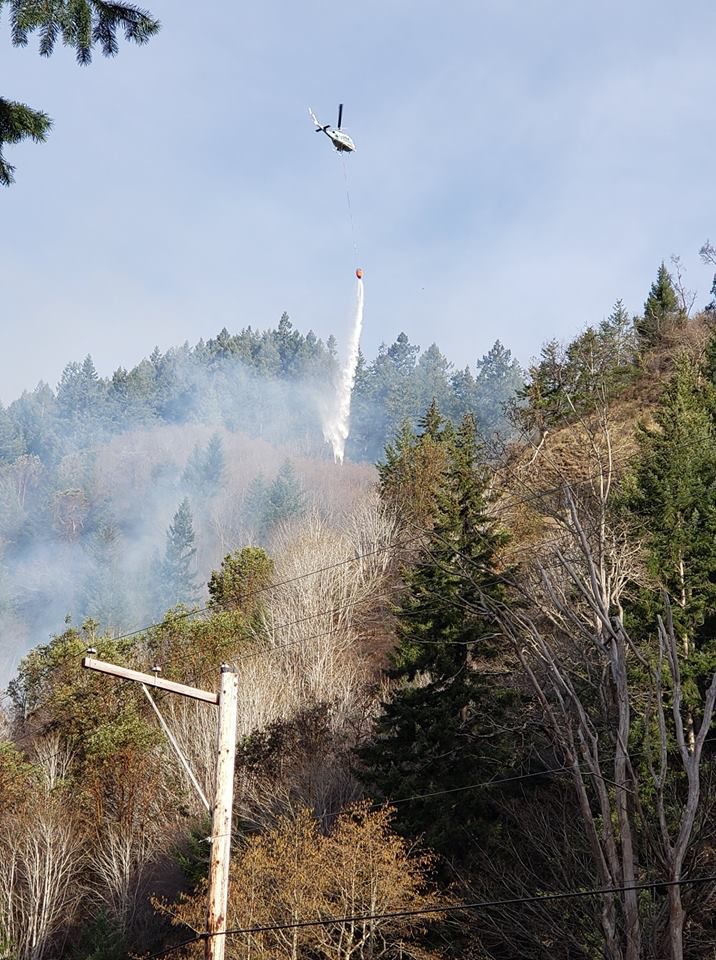About 40 firefighters and three state helicopters Wednesday fought a wildfire east of Cathlamet that was estimated Tuesday at 40 acres but had grown to 100 acres Wednesday. DNR Spokeswoman Mary McDonald said late Wednesday afternoon it is considered contained.
The fire, which broke out Tuesday and was spread by brisk gusts, burned up a steep slope on the north side of State Route 4 in the Little Cape Horn area. The highway remained opened, said Russ Truman, fire dispatch and prevention officer for the State Department of Natural Resources regional office in Castle Rock. (A previous online version of this story reported inaccurately that the highway had been closed.)
No evacuations were ordered in that area, he said.
The fire briefly threatened homes on the north side of the highway, but it changed course and the dwellings no longer are in jeopardy, Truman said.
McDonald said DNR responded to eight wildfires in its seven-county Southwest Region on Wednesday — three in Cowlitz, two in Lewis, two in Clark and one in Wahkiakum.
“We’re experiencing east winds for the last couple of days … it’s a lot drier here so we really need people to pay attention to these conditions,” McDonald said. “Lighting small fires … this is not the time to do it.”
Brush were reported on Carlon Loop and Ragland roads, which are in the Coal Creek area, while another was reported off Tower Road east of Castle Rock in the Toutle Valley, according to Cowlitz emergency dispatchers.
The Ragland Road fire was due to a brush burn that got out of control. Causes of other fires were not immediately known.
Another fire was reported along Maple Hill Road in the the Rose Valley area and was threatening a business, Matt’s Custom Meats. A business representative could not be reached for comment.
The fire is threatening about 100 homes and agricultural property. There are Level 3 (Go) evacuation notices in place, according to KATU. State resources were called in to assist at around 10 p.m., officials said. The evacuation order affects homes on Walker Road in Kelso and all roads off Walker Road, officials said. There was a Red Cross shelter open at Kalama High School overnight, but no one needed it.
McDonald said a DNR helicopter was rerouted from the wildfire near Cathlamet to Tower Road after reports the brush fire had reached a structure there. Further details were not available.
Agencies also responded around 2:15 p.m. to a fire in a field on the 400 block of Carlon Loop Road. The fire threatened homes around the field and on the hill. Crews mostly extinguished the flames about an hour later.
Linda Fittro lives on the hill and evacuated her home after a neighbor and fire officials alerted her of the fire. She said she’s lived there since 1984 and hasn’t seen a wildfire there before.
Tabitha Barrett said she called Fittro and her other Carlon Loop neighbors when she saw the flames quickly spreading.
“I watched trees go up in just seconds,” Barrett said. “I’m shocked they got it out so fast.”
About two miles up the hill, crews fought another grass fire off Ragland Road. Firefighters drove up and down driveways in an attempt to access a brush fire that started in a ravine. The fire threatened some homes but had not injured anyone or damaged any homes by Wednesday afternoon, Cowlitz 2 Fire Chief Dave LaFave said.
“There’s still some homes, one in particular that’s in a little bit of a critical spot, but I think it will be fine.”
“We are tapped,” LaFave said. “Our people are worn out. This is a record. I’ve been in this department 36 years, and I’ve never seen this. People need to stop burning. … There can’t be anything so pressing that (burning) needs to happen right now.”
Near a smoking hotspot up Ragland Road, LaFave pointed to a brush engine — a small fire truck with limited water supply — which was gingerly navigating its way down a winding driveway.
“See, that’s another issue,” LaFave said. “That’s just a brush engine, and he just barely makes it around that corner.”
The outbreak of fires Wednesday followed a frenzied day in which 15 wildfires broke out across DNR’s Southwest Washington region Tuesday.
“We’re looking at very dry conditions for this time of year,” said DNR’s Truman, reporting that burning blackberry thickets are sending flames 20 to 30 feet high. “Things are burning like they do in September.”
Cooler conditions and rain and showers over the next few days should take the edge off the fire hazards. However, “we need a good week of rain” to really dampen the danger, Truman said.
The cause of the Little Cape Horn fire has not been determined, but Truman advised anyone who has burned anything over the winter to check for lingering hot spots or embers.



